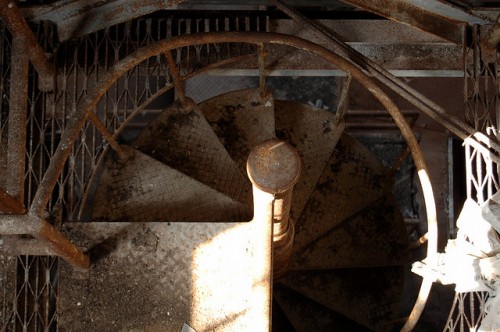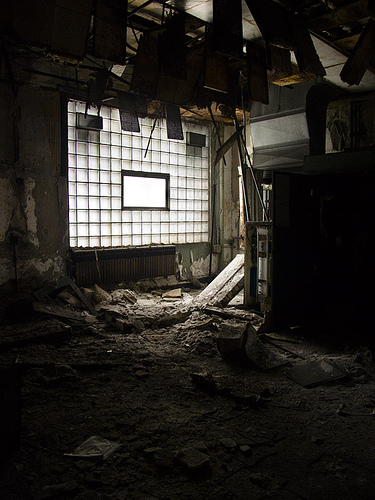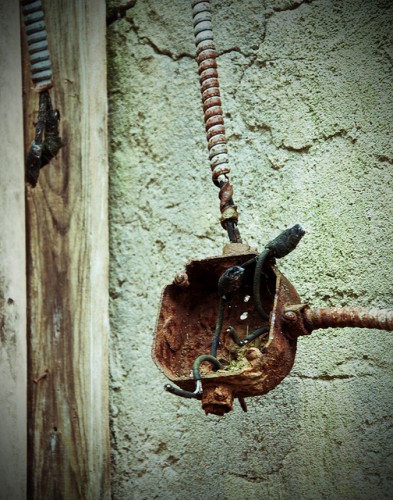This is the second part of a two-part essay; the full version of the essay — both parts — can be found here.

In part one of this essay, I focused on the atemporality of the physical spaces from which “ruin porn” images are made. This may have seemed like a bit of an aside from a take that purports to be technology-focused, but I want to emphasize the importance of physicality here–one of the crucial – if not the most crucial – ideas behind atemporality in the sense in which I use the word is the profound connection between our perception and understanding of time and our relationship with the enmeshed physical/digital world that our technology is increasingly helping to create. In short, we cannot discuss the digital in this case without first establishing why and how the physical matters.
But now I want to focus on that move from physical to digital, the point of entanglement where one shades into another and the relationship between the two becomes truly complex. I want to talk about the image itself, both in terms of its production and its consumption.
The Ghostly Construction of the Ruined Image
Last week I expended a fair number of words talking about the actual experience of the ruined space that necessarily accompanies capturing its image. I emphasized the importance of the imagination in the atemporal nature of this experience–the construction of both an imagined past and an imagined future in light of the perception of the present. I characterized these spaces as heterotopias – spaces outside the realm of the static, the linear, and the knowable. What we now have to turn to is the idea that there is a subtle but important difference between the physical experience of these spaces and the digitally-mediated experience of viewing their images.
First, there is the removal of aspects of the experience of time itself – even if the spaces are temporal heterotopias, one still experiences one’s own time within them: there is the process of finding and approaching the space, of entering it, of spending time inside it, and then of leaving it behind. If the important thing about the atemporality of ruined space is the construction of imagined pasts and futures, that construction may work quite differently when the spaces are experienced through immediate static images rather than gradual entry and exit. The nature of the space itself is changed when its image is all that is perceived.
Second, the image may or may not hold a close connection with the place itself. In her work on the philosophy of photography, Susan Sontag presented the act of photographing something as simultaneously the documenting of fact and the creation of fiction. There is a real space that is really photographed – but the photograph will never capture all of the space. It is the image that the photographer chooses to capture and share; it is an artifact of the photographer’s own perception of a space. Further, the image will frequently be altered in post-production.
The point is that by the time the image is shared, it may or may not bear much resemblance to space from which it was created. If we understand these spaces as time-laden as well as atemporal, then it makes sense to suppose that the aesthetics of the images of these spaces can shape the constructions of pasts, presents, and futures on the part of the people who view the images. Just as a photographer brings her own understandings and imaginings of ruined past and ruined future to the experience of a space, so the viewer of the photograph of a ruined space does not and cannot experience the image in isolation from her own internal narratives regarding what the past was, what the present is, and what the future may be.

Then there is the question of the context in which the image is viewed – and this is where we must turn to a discussion of the term “ruin porn” itself, and why it is at once both useful and problematic. It’s practically impossible to be in a ruined or abandoned space and have no idea at all of its context; the explorer or photographer sees the surroundings in which the space rests, sees where it is embedded in the larger structure of a city or a rural area, and can usually draw at least rough conclusions about what the space is, what it was, and what happened to it. Though the space is atemporal, it does have a history, and being inside the space gives one at least a chance of making a passing connection to that history simply by virtue of being there at all.
But a digital image viewed on a screen is inherently disconnected from that context, unless that information is presented with the image, or unless the viewer of the image cares enough to seek that context out – which, in a digital space, can mean an extremely diverse set of paths to an extremely diverse set of resources and media. And this has direct consequences for how the various imagined timeframes associated with the image are constructed. What do we know about a place from an image and about its past? How do we know it? What are we simply assuming or making up out of whole cloth? And how do these forms of knowledge and these assumptions shape our understanding of our presents and our imagining of our futures?
In an instant, we can see a constructed image of decay and ruin that leads us to further constructions of past, present, and future. And these constructions may be wildly diverse and wildly divergent depending on the perspective and knowledge of the viewer. Abi Sutherland of Making Light characterized these images as “like a story prompt, the visual equivalent of a Mad Lib gone melancholic, and the topic is our own lives.” What is atemporal on this end lies in the fabric of the stories we tell to ourselves about ourselves and how we weave those disparate stories together. And we can do this in the way we do this because of the digital nature of these images and because of the digital nature of so much of our accumulated knowledge, and of how we accumulate that knowledge. There is no single authoritative source in this accumulation. If we are poets and scribes, we are also digital magpies; we pick and gather and aggregate from everywhere. As author Bruce Sterling says in “Atemporality for the Creative Artist”, what we have now instead of a singular narrative is a multiplicity of narratives drawn from a multiplicity of sources, expressed in a wild multiplicity of ways.
A story of my own: Not far from where I live in Maryland there’s a park that contains the ruins of a mill town that was mostly washed away in a flood in 1972. Not much of it remains, but one day I and my husband went exploring to see what we could still find. In the process of compiling the images we captured, we did a fair amount of research on the town itself, including digging up old photographs of the town as it was when it was inhabited and intact.

That process made me experience my memory of the town differently than I had when I was physically there. It also made me see our captured images of the town differently. Suddenly they were contextualized. It isn’t that the images made no sense before they were placed in context. It isn’t that images of ruin without historical context are senseless and meaningless. Far from it. But we must understand the sense that is made of them as potentially very different in that case. What we know shapes what we know. What we see shapes what we know. And what we know shapes a great deal of what we see and imagine.
It is in this sense that many people find both the term and the idea of “ruin porn” a problem. Many of the American-produced images that arguably fall under the category of “ruin porn” are artifacts of buildings, industries, and communities that have been casualties of modern American capitalism, and especially the process of deindustrialization that has occurred in many American urban centers, which has been devastating to minorities and the urban poor. Many of these images have come out of the shell of the American Rust Belt, leading to criticisms on the part of some that the images do not do justice to either the historical context or the present state of these spaces – as evidence of rampant social inequality and a failed welfare state – and that the photographs essentially construct the present of the spaces as more ruined and abandoned then they really are, given that many people may still live in or near them. In essence, they are accused of constructing a romantically gritty and melancholic vision of a past that allows viewers to avoid the more unpleasant understandings of a present or the even less pleasant prospect of a future marked by the scars of social inequality. As Sean Posey of Rustwire writes,
One of the best criticisms of photographs of abandonment, especially those made by photojournalists, is the failure to include people who live in these areas. There are still 700,000 plus people in Detroit, most of whom are African American. Their invisibility in photographic documentations is directly related to their invisibility in policy circles, or in discussions of urban revitalization. In a way, accentuating the lack of people leads to notions that no one lives in these areas. Ruins become more about the past and what once was, instead of the present.
But Abandoned America photographer Matthew Christopher takes issue with what he feels is the distraction that the term itself presents – a way of dismissing what the images represent and what they suggest without engaging directly in a discussion of what capturing and viewing these images actually means for artists and consumers of art, and for all of us as atemporal storytellers in an augmented world:
While the term is extraordinarily useful for brushing off the significance of an entire genre of work, it is much less useful for entering an actual discussion. It breezily dismisses the subject as perverse and pointless with the same carefree lack of thought and responsibility that the original photographers who were described with the term were accused of having. When examined more thoroughly, much like the topic of abandoned spaces, it reveals a wealth of material worthy of pondering. What are the responsibilities of an artist or photographer to their subject, and should they be chastised for attempting to make a profession of documenting ruins?…More to the point, is existing as an object of beauty justifiable in and of itself or must it ‘accomplish’ something? Must a photograph present both sides of a story?
The questions I would add to those posed by Christopher have to do with time and our perception of it. What do images of ruined places mean for our understanding of history? What do they mean for how we understand our own mortality and transience? What do they do to our perceptions of time itself? What implications does the fabric of our constructions of past and future have for how we accumulate and value various forms of knowledge?
If the term “ruin porn” has any utility, it may lie in the reminder it presents that what we see is only what we see, and what we see is often the construction of a set of eyes different from our own. Just as pornography is a mediated creation based on sex without being an actual, unmediated representation of the act itself, we should understand images of anything in the same terms without mistaking them for the “real thing” – if for no other reason than because the “real thing” may prove impossible to pin down, both in terms of time and in terms of space. Images of ruined spaces are like temporal ghost stories: it is difficult to be sure if what we see is truly a fragment of an objective past, an echo of our own future, or simply a shifting chiaroscuro–a play of digital shadows and light.

Comments 1
Links – January 20, 2012 | zota — January 21, 2012
[...] The Atemporality of “Ruin Porn” – Part II: The Ghost » Cyborgology [...]